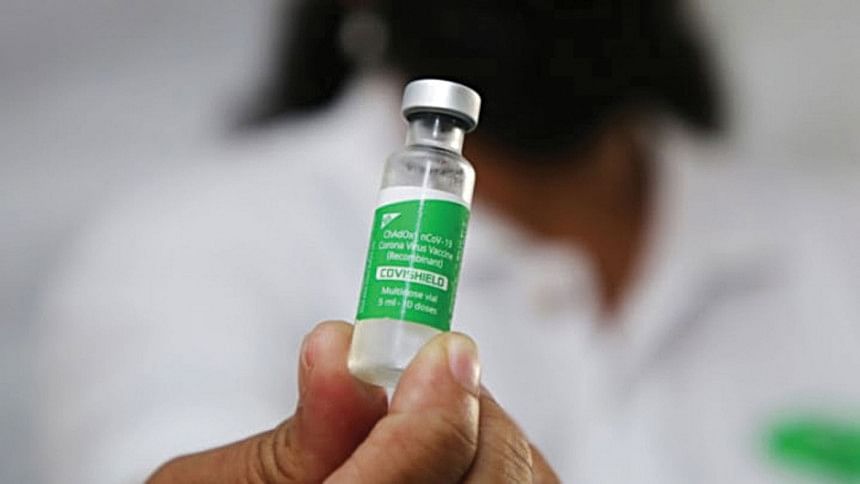Experts' Views: Can we administer different vaccine for 2nd dose?

Devastated by the second wave of the pandemic, India has imposed a ban on all kinds of vaccine exports.
As a result, Bangladesh is not receiving the pre-purchased and already paid for 30 million doses of Oxford-AstraZeneca (Covishield) shots from Serum Institute. Till date, we have received only 7 million doses from Serum Institute, and 3.2 million doses as a gift from the Indian government.
In total, we have received 10.2 million doses. It is highly unlikely that we will get the additional vaccines from Serum Institute any time before July.
Due to this, the countrywide vaccination programme that started in Bangladesh in February is facing a bump on the road since April
The government has put a hold on administering the first dose due to scarcity of vaccines. Now, only the second doses are being administered.
With the amount of shots in hand, the scheduled second doses for some 1.3 million people on time have become uncertain. As per the World Health Organization's guidelines, in order to achieve full protection, the second dose has to be taken within 12 weeks of receiving the first dose. If taken later, the level of protection offered by the vaccine may decline.
The government is now desperately trying to procure vaccines from other sources. The country's Directorate General of Drug Administration has already approved Russia's Sputnik-V and China's BBIBP-CorV vaccines for emergency usage; and given nod for local co-production.
There is a possibility of receiving 0.5 million shots from Sinopharm within the next two weeks.
Can we, however, implement the "mix and match" strategy using the Sputnik-V or the Sinopharm vaccine with the Oxford-AstraZeneca vaccine to continue our vaccination feat? As in, can the people who have already received the first dose of Covishield be administered Sputnik-V or Sinopharm as the second dose? The second question is are these vaccines effective and safe?
Sputnik-V or BBIBP-CorV is yet to receive the nod from the World Health Organization. These vaccines have not received approval from European regulator (EMA), UK's regulator MHRA or the US regulator FDA either.
Recently, India, however, has given approval for using Sputnik-V in their country.
Drug Regulators of different countries determine how safe and effective a new drug or a vaccine is. This approval process is quite complicated and time consuming.
In order to complete this process, a panel of experts scrutinise all kinds of laboratory and clinical trial data of the vaccines thoroughly. Given the current circumstances, it takes at least three to four weeks for this process to complete.
In this regard, how did Bangladesh approve these two vaccines within such a short time? Has Bangladesh ever approved a vaccine that has not been pre-approved by WHO or FDA?
How effective and safe is Sputnik-V?
As per the Phase-3 trial results of Sputnik-V, published in the Lancet on 20 February 2021, the effectiveness of the two doses, given 21 days apart, is 92 percent.
The effectiveness of a single dose is 74 percent that begins from 14 days after the shot. Some 22 thousand adult volunteers in Russia took part in the trial phase, which continued from September to November last year.
No severe side effects were observed in the vaccine trial. A few deaths were reported during trial, but later was cleared as unrelated to the vaccine. The effectiveness of the vaccine on adults (18-60 year) was quite similar to the elderly.
However, only the frozen formulation of this vaccine has been tested during the Phase-3 trial. The storing temperature for the frozen vaccine is -18 degree Celsius. Another formulation of this vaccine is its powder or lyophilized form, which can be stored at 4-8 degree Celsius in a regular refrigerator.
This formulation has not yet been evaluated in the Phase-3 trial.
According to the phase one and two trial reports, published in the Lancet on September 8, 2020, both formulations were able to produce enough neutralising antibodies in the blood of all participants and it also elicited the desired "T-cell response".
The finding allows us to expect the similar effectiveness of the frozen form from the powder form of the vaccine. However, there must be adequate evidence in this regard. We should take this fact in consideration before choosing which formulation of Sputnik-V could be manufactured in Bangladesh.
This vaccine, which has been developed by the century old Gamalaya institute of Russia, is a heterogeneous adenovirus vector vaccine. Two different types of human adenovirus have been used for the two doses of this vaccine. A rare adenovirus species named Ad26 has been used for the first dose and a common species Ad5 adenovirus has been used for the second dose.
Using DNA recombinant technology, a piece of coronavirus gene has been inserted inside the adenovirus vectors which are capable of producing Spike protein. These recombinant adenoviruses are injected into the muscle as shots, which produce the spike protein to elicit an immune response against the coronavirus and eventually, builds the protective immunity.
The other vaccines developed using adenovirus vector technology include Oxford-AstraZeneca, Johnson & Johnson and China's Cansinobio vaccine.
However, other than Sputnik-V, all vaccines of this category are single vector vaccine. In Oxford-AstraZeneca, Chimpanzee adenovirus has been used. On the other hand, Johnson & Johnson and Cansinobio has used Ad26 and Ad5 human adenovirus, respectively.
Meanwhile, a Phase-1/2 clinical trial was supposed to commence on March 30 this year in Russia, which was to determine whether Sputnik-V and Oxford-AstraZeneca vaccines can be administered as first and second doses.
However, according to clinicaltrials.gov, this trial, which was supposed to be completed by October, has not yet started. Thus, until this trial is complete, we cannot say for sure whether mixing and matching these two vaccines will be effective, or whether it will cause any dangerous side effects or not.
Scientists, on the other hand, have opined that as both vaccines are from the same platform, administering them in a mixed and matched manner may prove effective.
The Covid-19 vaccine of Sinopharm is a killed or inactivated vaccine. In this procedure, the coronavirus is rendered inactive using chemicals and then administered as vaccine. This is a traditional tried-and-trusted method of making vaccines. Another Chinese vaccine Sinovac, India's Covaxin and France's Valneva vaccines are all killed Covid-19 vaccines.
Sinopharm is developing two Covid vaccines funded by the Chinese government. One is being developed in the Beijing institute and the other in Wuhan. Bangladesh is purchasing the vaccine that comes from Beijing.
The Phase-3 clinical trial results of the Sinopharm vaccine are yet to be published in any journal. Thus, the effectiveness and side effects related details for this vaccine is not yet available. The Phase-3 trial took place in the United Arab Emirates, Egypt, Bahrain, Peru and Morocco.
As per the press release by the Sinopharm, after two doses given 28 days apart, the effectiveness of the vaccine (Beijing Institute) is 79 percent. On the other hand, the Wuhan version shows an effectiveness of 72 percent.
None of the trials has shown any serious side effects, as reported in a commentary published in the BMJ, 9 April 2021. Now, the Sinopharm vaccine is awaiting the WHO approval. The decision is anticipated to be made by next week.
Previously, Sinopharm conducted the first two phases of their vaccine's trial on 96 and 224 volunteers, respectively. Fourteen days after receiving the jabs, enough neutralising antibodies were generated within the blood of 86 percent of the volunteers. However, this vaccine failed to generate the desired T-cell response, as published in the JAMA journal on August 13, 2020. For this reason, the longevity of the immunity created by this vaccine could be less, at least in theory.
Bangladesh will be receiving half a million Sinopharm vaccines within the next two weeks. Now the question is whether this vaccine can be mixed and matched, and used along with the Oxford-AstraZeneca vaccine. As in, can the people who received the Covishield vaccine as the first dose, safely receive the Sinopharm vaccine as the second dose? The answer is still unknown.
Sinopharm and Covishield vaccines come from totally different platforms. One is a killed vaccine and the other is a live adenovirus vector vaccine. The effects and immunogenic responses of these vaccines are totally different. Currently, the UK is conducting a trial on mixing and matching the Oxford vaccine with mRNA vaccines, such as Pfizer and Moderna.
The Sputnik-V vaccine uses modern technology and its price per dose is only 10 US dollars. This vaccine has been approved in over 60 countries.
Perhaps this vaccine will soon get approval from the World Health Organization as well. The powder formulation of this vaccine can be most suitable in our country's perspective. However, we need to assess whether it's complicated production process can be easily replicated in Bangladesh for local production.
On the other hand, the Sinopharm vaccine uses traditional production procedures and can easily be manufactured by our local pharmaceutical companies. The Phase-3 trial results of this vaccine still remains unpublished. Thus, we should only administer it to our countrymen after it gets WHO approval. Each dose of this vaccine costs 35 US dollars. If we can produce it locally, the price may be brought down a notch.

 For all latest news, follow The Daily Star's Google News channel.
For all latest news, follow The Daily Star's Google News channel. 



Comments